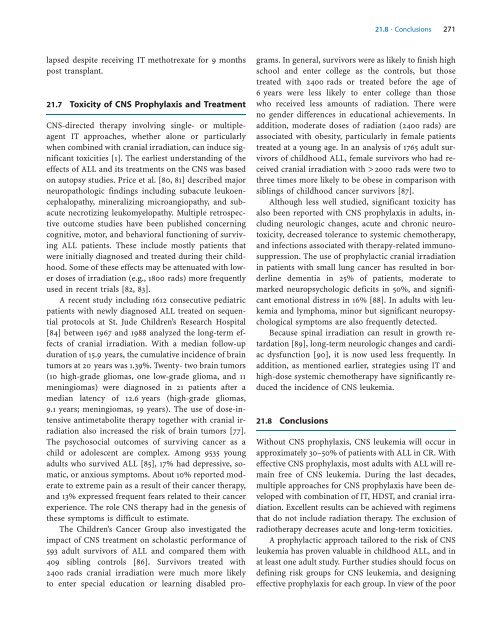Acute Leukemias - Republican Scientific Medical Library
Acute Leukemias - Republican Scientific Medical Library
Acute Leukemias - Republican Scientific Medical Library
You also want an ePaper? Increase the reach of your titles
YUMPU automatically turns print PDFs into web optimized ePapers that Google loves.
a 21.8 · Conclusions 271<br />
lapsed despite receiving IT methotrexate for 9 months<br />
post transplant.<br />
21.7 Toxicity of CNS Prophylaxis and Treatment<br />
CNS-directed therapy involving single- or multipleagent<br />
IT approaches, whether alone or particularly<br />
when combined with cranial irradiation, can induce significant<br />
toxicities [1]. The earliest understanding of the<br />
effects of ALL and its treatments on the CNS was based<br />
on autopsy studies. Price et al. [80, 81] described major<br />
neuropathologic findings including subacute leukoencephalopathy,<br />
mineralizing microangiopathy, and subacute<br />
necrotizing leukomyelopathy. Multiple retrospective<br />
outcome studies have been published concerning<br />
cognitive, motor, and behavioral functioning of surviving<br />
ALL patients. These include mostly patients that<br />
were initially diagnosed and treated during their childhood.<br />
Some of these effects may be attenuated with lower<br />
doses of irradiation (e.g., 1800 rads) more frequently<br />
used in recent trials [82, 83].<br />
A recent study including 1612 consecutive pediatric<br />
patients with newly diagnosed ALL treated on sequential<br />
protocols at St. Jude Children’s Research Hospital<br />
[84] between 1967 and 1988 analyzed the long-term effects<br />
of cranial irradiation. With a median follow-up<br />
duration of 15.9 years, the cumulative incidence of brain<br />
tumors at 20 years was 1.39%. Twenty- two brain tumors<br />
(10 high-grade gliomas, one low-grade glioma, and 11<br />
meningiomas) were diagnosed in 21 patients after a<br />
median latency of 12.6 years (high-grade gliomas,<br />
9.1 years; meningiomas, 19 years). The use of dose-intensive<br />
antimetabolite therapy together with cranial irradiation<br />
also increased the risk of brain tumors [77].<br />
The psychosocial outcomes of surviving cancer as a<br />
child or adolescent are complex. Among 9535 young<br />
adults who survived ALL [85], 17% had depressive, somatic,<br />
or anxious symptoms. About 10% reported moderate<br />
to extreme pain as a result of their cancer therapy,<br />
and 13% expressed frequent fears related to their cancer<br />
experience. The role CNS therapy had in the genesis of<br />
these symptoms is difficult to estimate.<br />
The Children’s Cancer Group also investigated the<br />
impact of CNS treatment on scholastic performance of<br />
593 adult survivors of ALL and compared them with<br />
409 sibling controls [86]. Survivors treated with<br />
2400 rads cranial irradiation were much more likely<br />
to enter special education or learning disabled pro-<br />
grams. In general, survivors were as likely to finish high<br />
school and enter college as the controls, but those<br />
treated with 2400 rads or treated before the age of<br />
6 years were less likely to enter college than those<br />
who received less amounts of radiation. There were<br />
no gender differences in educational achievements. In<br />
addition, moderate doses of radiation (2400 rads) are<br />
associated with obesity, particularly in female patients<br />
treated at a young age. In an analysis of 1765 adult survivors<br />
of childhood ALL, female survivors who had received<br />
cranial irradiation with > 2000 rads were two to<br />
three times more likely to be obese in comparison with<br />
siblings of childhood cancer survivors [87].<br />
Although less well studied, significant toxicity has<br />
also been reported with CNS prophylaxis in adults, including<br />
neurologic changes, acute and chronic neurotoxicity,<br />
decreased tolerance to systemic chemotherapy,<br />
and infections associated with therapy-related immunosuppression.<br />
The use of prophylactic cranial irradiation<br />
in patients with small lung cancer has resulted in borderline<br />
dementia in 25% of patients, moderate to<br />
marked neuropsychologic deficits in 50%, and significant<br />
emotional distress in 16% [88]. In adults with leukemia<br />
and lymphoma, minor but significant neuropsychological<br />
symptoms are also frequently detected.<br />
Because spinal irradiation can result in growth retardation<br />
[89], long-term neurologic changes and cardiac<br />
dysfunction [90], it is now used less frequently. In<br />
addition, as mentioned earlier, strategies using IT and<br />
high-dose systemic chemotherapy have significantly reduced<br />
the incidence of CNS leukemia.<br />
21.8 Conclusions<br />
Without CNS prophylaxis, CNS leukemia will occur in<br />
approximately 30–50% of patients with ALL in CR. With<br />
effective CNS prophylaxis, most adults with ALL will remain<br />
free of CNS leukemia. During the last decades,<br />
multiple approaches for CNS prophylaxis have been developed<br />
with combination of IT, HDST, and cranial irradiation.<br />
Excellent results can be achieved with regimens<br />
that do not include radiation therapy. The exclusion of<br />
radiotherapy decreases acute and long-term toxicities.<br />
A prophylactic approach tailored to the risk of CNS<br />
leukemia has proven valuable in childhood ALL, and in<br />
at least one adult study. Further studies should focus on<br />
defining risk groups for CNS leukemia, and designing<br />
effective prophylaxis for each group. In view of the poor
















